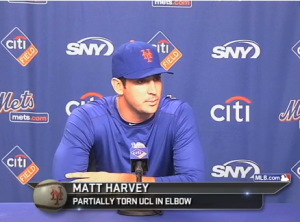 The New York Mets experienced a big blow to their short-term fortunes today. Their ace, the pitcher that earned the start for the National League in this year’s All Star Game, Matt Harvey, was diagnosed with a partially torn ulnar collateral ligament (UCL) in his elbow. The surgery to repair, actually replace that, is commonly referred to as “Tommy John surgery.”
The New York Mets experienced a big blow to their short-term fortunes today. Their ace, the pitcher that earned the start for the National League in this year’s All Star Game, Matt Harvey, was diagnosed with a partially torn ulnar collateral ligament (UCL) in his elbow. The surgery to repair, actually replace that, is commonly referred to as “Tommy John surgery.”
Yep. Matt Harvey likely needs Tommy John surgery, and will be out for the rest of this year and 2014.
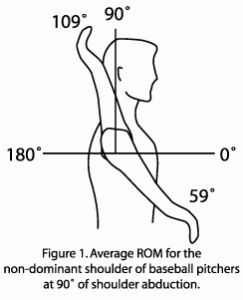 Why did this happen? Moving your arm as rapidly as you can from external (behind your shoulder) to internal (in front of your torso) rotation creates very strong forces in your arm, primarily in your elbow. The repetitive stress on the ligament in your elbow leads to lengthening, tearing and wearing down of the UCL which in turn causes medial (inner) elbow pain, decrease in velocity of throwing, and an inability to throw effectively.
Why did this happen? Moving your arm as rapidly as you can from external (behind your shoulder) to internal (in front of your torso) rotation creates very strong forces in your arm, primarily in your elbow. The repetitive stress on the ligament in your elbow leads to lengthening, tearing and wearing down of the UCL which in turn causes medial (inner) elbow pain, decrease in velocity of throwing, and an inability to throw effectively.
Everyone’s ability to create speed and force is different. Everyone’s efficiency is unique to them. Chris Young, the 6’ 10” 278lb pitcher currently with the Washington Nationals rarely tops 87 mph, but 5’ 9” 185lb Pedro Martinez threw as fast as 94 mph. Everyone organizes their movements differently. And everyone’s UCL reacts somewhat differently.
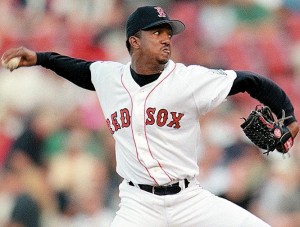 According to Dr. Seth Gamradt of the USC Keck School of Medicine, most commonly a UCL tear presents with a gradual onset of medial (middle) elbow pain due to repetitive stresses on the ligament; this is called a chronic UCL tear. Occasionally, throwing athletes may experience a sharp “pop” or develop sharp pain along the inside of the elbow joint on one particular throw; this is called an acute UCL tear. Either way, the tear in the ligament leads to a decrease in velocity, pain while pitching, and lack of control. Occasionally, the ulnar nerve, which runs very close to the UCL, can be stretched, leading to numbness and tingling in the small and ring fingers.
According to Dr. Seth Gamradt of the USC Keck School of Medicine, most commonly a UCL tear presents with a gradual onset of medial (middle) elbow pain due to repetitive stresses on the ligament; this is called a chronic UCL tear. Occasionally, throwing athletes may experience a sharp “pop” or develop sharp pain along the inside of the elbow joint on one particular throw; this is called an acute UCL tear. Either way, the tear in the ligament leads to a decrease in velocity, pain while pitching, and lack of control. Occasionally, the ulnar nerve, which runs very close to the UCL, can be stretched, leading to numbness and tingling in the small and ring fingers.
How can you prevent the UCL from rupturing? The only absolutely certain way is not to pitch a baseball at close to your potential velocity. Really. Like driving a Ferrari at 40 miles per hour, you are not likely to stress the engine ever. Or the braking system.
If anyone tells you that the way they pitch or teach pitching will absolutely never lead to an injury, they are full of horse hockey pucks. Every movement, every action has an implication. Everyone’s body is somewhat different. And no one can predict the future. Do you think the Mets value Matt Harvey’s contributions? And the Nationals value Stephen Strassberg? You bet, and every club would love to avoid as many injuries as they can to their players.
How can you prevent the UCL from rupturing? The only absolutely certain way is not to pitch a baseball at close to your potential velocity. Really. Like driving a Ferrari at 40 miles per hour, you are not likely to stress the engine ever. Or the braking system.
If anyone tells you that the way they pitch or teach pitching will absolutely never lead to an injury, they are full of horse hockey pucks. Every movement, every action has an implication. Everyone’s body is somewhat different. And no one can predict the future. Do you think the Mets value Matt Harvey’s contributions? And the Nationals value Stephen Strasberg? You bet, and every club would love to avoid as many injuries as they can to their players.
But there are things you can do. You can reduce your chances of having an injury by:
Start preparing early. Starting your preseason training about least ten weeks before your team starts working together.
Frequent workouts. Working out at least every other day, but no more than six days a week.
Train baseball movements and muscles. Train all parts of your body that help you perform on the field with short-length explosive exercises.
Start your competitive season gradually. Don’t try to throw 115 pitches your first time out, especially if its cold outside. Build up your
Warm up completely before each appearance. Don’t wait to be told. Do it on your own.
Recover intelligently. Heat speeds up the flow of blood and helps your muscles, tendons, and ligaments recover. Use ice only to reduce swelling of injuries (and pitching is not an injury).
Avoid multiple high-stress innings in each game. Discuss this with your coach and get on the same page. If you have a long inning (30 or more pitches), then you need to get off the mound before trying to complete another one. Normal innings (12-18 pitches) are fine.
Having an offseason is fine. You can refrain from any baseball activity to clear your head and let your body recover. For some, two weeks is enough for that. For others, they need two or three months. But remember, you should be doing some semi-challenging athletic activity for 11 to 11 ½ months out of the year. Other sports are fine, as are challenging recreational activities.
We’ll be producing some training to help you with the cycle above. Look for it.
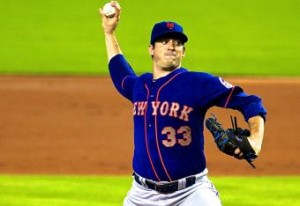 Why did Matt Harvey get injured? It’s a complex answer. The simple answer is that he wore down his UCL over time. Like most pitchers, he was a bit more efficient in his ability to accelerate than decelerate. He pitched more pitches this year than he has in any year of his life. Most importantly, he’s added more innings total to his historical total. Could it have been avoided? Likely no.
Why did Matt Harvey get injured? It’s a complex answer. The simple answer is that he wore down his UCL over time. Like most pitchers, he was a bit more efficient in his ability to accelerate than decelerate. He pitched more pitches this year than he has in any year of his life. Most importantly, he’s added more innings total to his historical total. Could it have been avoided? Likely no.
Good luck in your recovery, Matt.

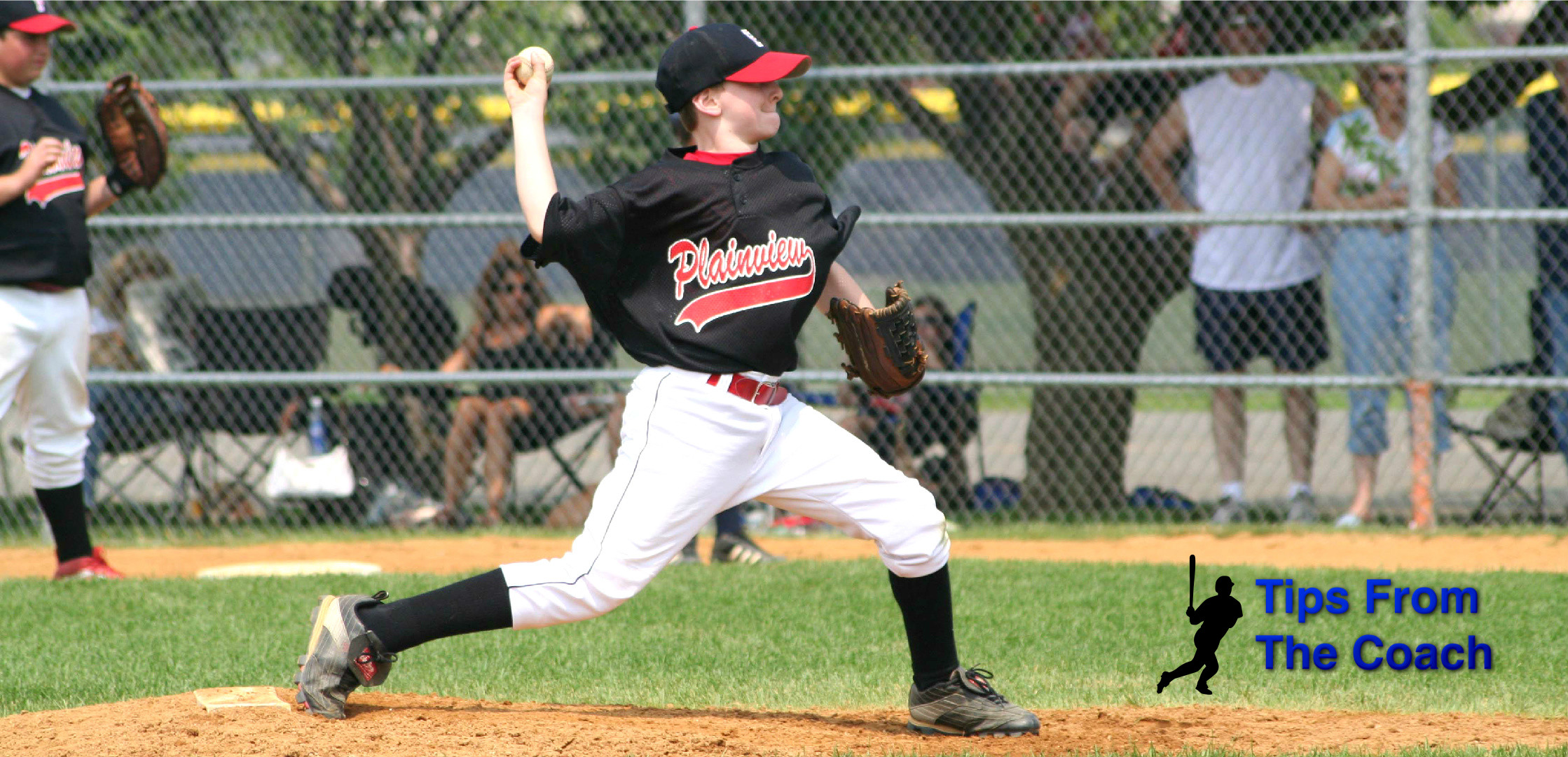


No Comments
No comments yet.
RSS feed for comments on this post.
Sorry, the comment form is closed at this time.